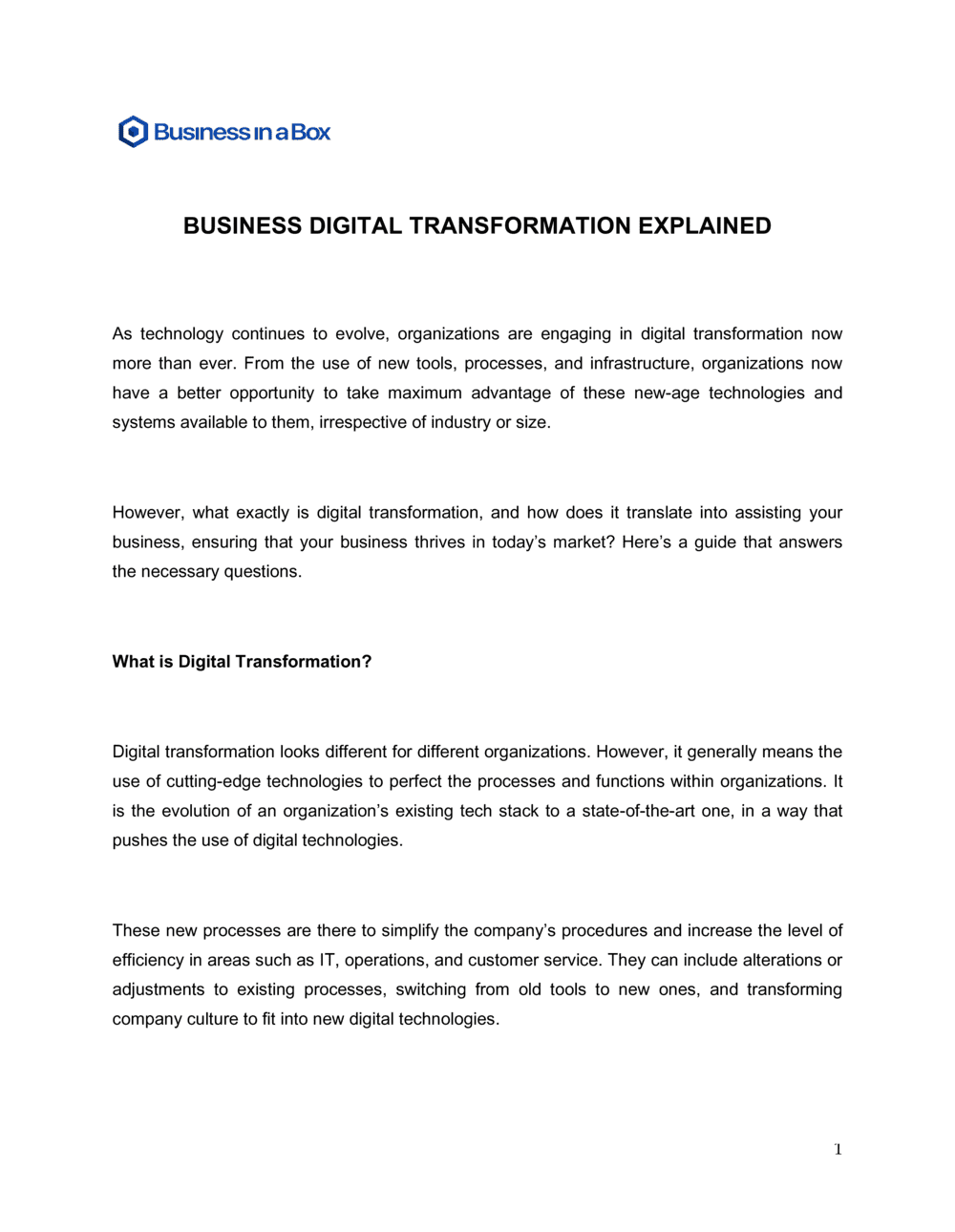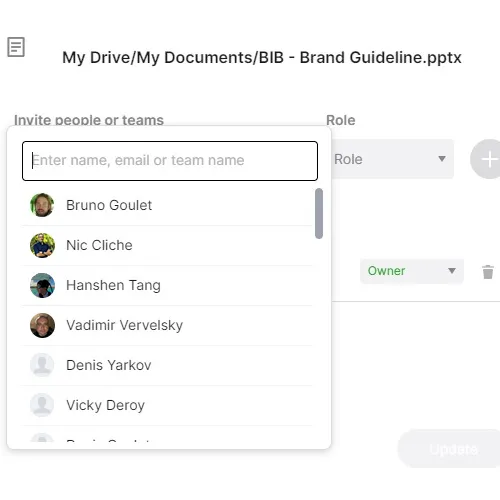Business Digital Transformation Explained Template

Sample of Document Content
This business digital transformation explained template has 3 pages and is a MS Word file type listed under our business plan kit documents.
Business digital transformation explained template
BUSINESS DIGITAL TRANSFORMATION EXPLAINED As technology continues to evolve, organizations are engaging in digital transformation now more than ever. From the use of new tools, processes, and infrastructure, organizations now have a better opportunity to take maximum advantage of these new-age technologies and systems available to them, irrespective of industry or size. However, what exactly is digital transformation, and how does it translate into assisting your business, ensuring that your business thrives in today's market? Here's a guide that answers the necessary questions. What is Digital Transformation? Digital transformation looks different for different organizations. However, it generally means the use of cutting-edge technologies to perfect the processes and functions within organizations. It is the evolution of an organization's existing tech stack to a state-of-the-art one, in a way that pushes the use of digital technologies. These new processes are there to simplify the company's procedures and increase the level of efficiency in areas such as IT, operations, and customer service. They can include alterations or adjustments to existing processes, switching from old tools to new ones, and transforming company culture to fit into new digital technologies. The Four Key Areas of Digital Transformation There are four major areas that your organization may build on to adopt digital transformation: Collaboration Transformation This is an important aspect of digital transformation for businesses, as it's a means of shifting the way team members work, enabling them to collaborate and do meaningful work together, even without being in the same space. Digital collaboration transformation is possible when there's the use of project management and collaboration platforms like Microsoft Teams, Microsoft 365, and Asana. It includes communication platforms like Slack, which helps in presenting a better shift toward digital collaboration transformation. Disaster Recovery and Business Continuity Transformation When we consider the levels that technology has achieved in recent times, it becomes more obvious that disaster recovery and business continuity should be important aspects of any digital transformation strategy. The returns of digital transformation include adaptable IT infrastructure, new antivirus software, and cloud security. Digital transformation is a chance for organizations to become more flexible, secure, and adaptable. Beyond this, organizations become more responsive to situations and make it much more possible for employees to maintain productivity in the event that there's a breach, failure, or crash. Cybersecurity Transformation One important aspect that businesses have to pay attention to as they continue to go digital is that it will have a huge impact on cybersecurity
Reviewed on

Sample of Document Content
This business digital transformation explained template has 3 pages and is a MS Word file type listed under our business plan kit documents.
Sample of our business digital transformation explained template:
BUSINESS DIGITAL TRANSFORMATION EXPLAINED As technology continues to evolve, organizations are engaging in digital transformation now more than ever. From the use of new tools, processes, and infrastructure, organizations now have a better opportunity to take maximum advantage of these new-age technologies and systems available to them, irrespective of industry or size. However, what exactly is digital transformation, and how does it translate into assisting your business, ensuring that your business thrives in today's market? Here's a guide that answers the necessary questions. What is Digital Transformation? Digital transformation looks different for different organizations. However, it generally means the use of cutting-edge technologies to perfect the processes and functions within organizations. It is the evolution of an organization's existing tech stack to a state-of-the-art one, in a way that pushes the use of digital technologies. These new processes are there to simplify the company's procedures and increase the level of efficiency in areas such as IT, operations, and customer service. They can include alterations or adjustments to existing processes, switching from old tools to new ones, and transforming company culture to fit into new digital technologies. The Four Key Areas of Digital Transformation There are four major areas that your organization may build on to adopt digital transformation: Collaboration Transformation This is an important aspect of digital transformation for businesses, as it's a means of shifting the way team members work, enabling them to collaborate and do meaningful work together, even without being in the same space. Digital collaboration transformation is possible when there's the use of project management and collaboration platforms like Microsoft Teams, Microsoft 365, and Asana. It includes communication platforms like Slack, which helps in presenting a better shift toward digital collaboration transformation. Disaster Recovery and Business Continuity Transformation When we consider the levels that technology has achieved in recent times, it becomes more obvious that disaster recovery and business continuity should be important aspects of any digital transformation strategy. The returns of digital transformation include adaptable IT infrastructure, new antivirus software, and cloud security. Digital transformation is a chance for organizations to become more flexible, secure, and adaptable. Beyond this, organizations become more responsive to situations and make it much more possible for employees to maintain productivity in the event that there's a breach, failure, or crash. Cybersecurity Transformation One important aspect that businesses have to pay attention to as they continue to go digital is that it will have a huge impact on cybersecurity
Easily Create Any Business Document You Need in Minutes.

Download or open template
Access over 3,000+ business and legal templates for any business task, project or initiative.

Edit and fill in the blanks
Customize your ready-made business document template and save it in the cloud.

Save, Share, Export, or Sign
Share your files and folders with your team. Create a space of seamless collaboration.


